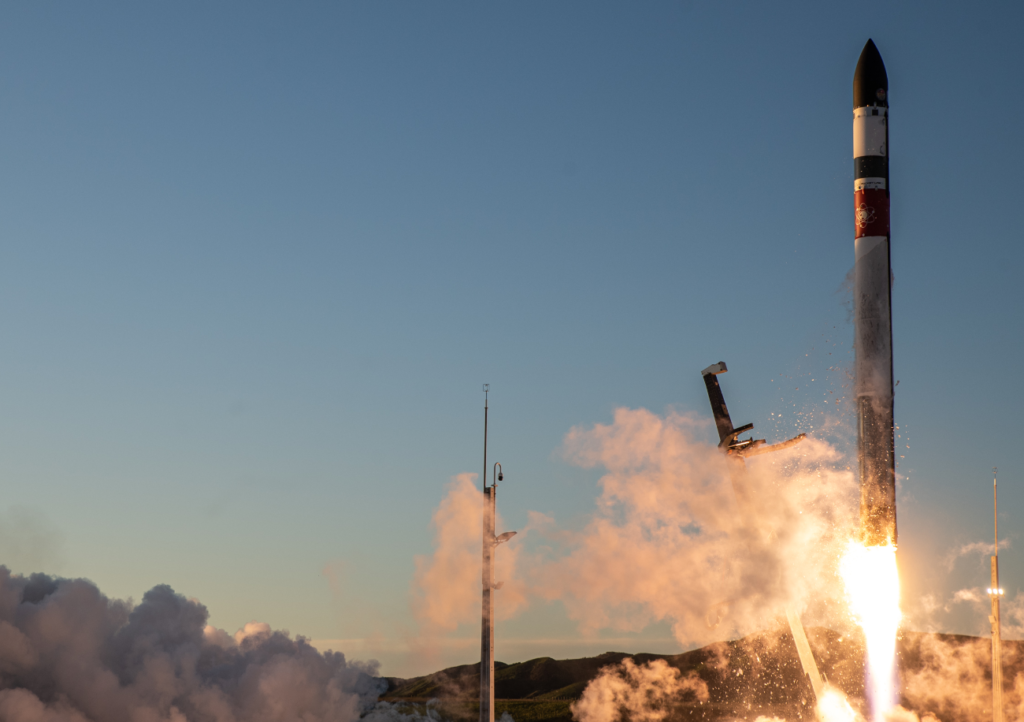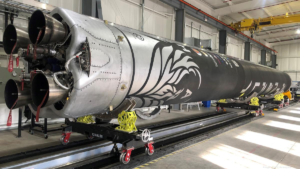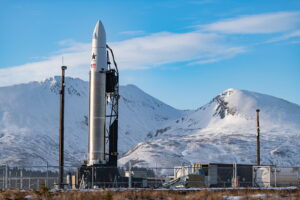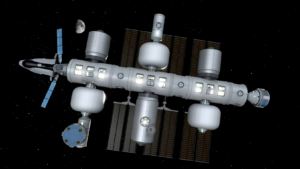
Rocket Lab Successfully Completes Another Electron Launch
Rocket Lab has had a very busy year so far and accomplished a list of different milestones. Just over a month ago, we watched the launch of CAPSTONE and part of the journey to the Moon. Now in early August, the company is continuing to launch Electron. A big part of Rocket Lab’s busy schedule is thanks to the addition of Pad B not long ago to the launch complex.
In terms of the most recent launch, just yesterday Rocket Lab successfully delivered the payload apart of NROL199. This was the second launch in a two launch mission with the initial payload sent to space only weeks prior. Specifically, the first mission, Wise One Looks Ahead (NROL-162) successfully lifted off from Launch Complex 1 on July 13, 2022.
The NROL-199 mission carried a national security payload designed, built, and operated by the National Reconnaissance Office in partnership with the Australian Department of Defence as part of a broad range of cooperative satellite activities with Australia. Here I will go more in-depth into the recent launch success, what’s next for Rocket Lab, and what to expect in the coming months.
Recent Launch

Just yesterday Rocket Lab launched once again. It began with a tweet highlighting, “We have lift-off from Launch Complex 1 for NROL-199!” Soon after, the company continued to provide updates on the mission. Rocket Lab then tweeted saying, “Second stage cut-off confirmed, as planned. Final separation of Electron’s second stage and Kick Stage confirmed.” Finally, they updated that, “Now the Kick Stage is in a perfect transfer orbit, as planned. Around an hour from now the Curie engine will ignite to circularize its orbit ahead of payload deployment. Stay tuned for confirmation of payload deployment!” The last update from the company mentioned, “MISSION SUCCESS! Electron’s Kick Stage has successfully deployed the @NatReconOfC’s payload to orbit. Welcome to your new home in space, #NROL199!”
Specifically, the NROL-199 “Antipodean Adventure” mission launched on the Electron rocket from Pad B at Rocket Lab Launch Complex 1 at 05:00 UTC, August 4, 2022 carrying a payload designed, built, and operated by the NRO in partnership with the Australian Department of Defence. This mission follows the successful delivery to orbit of its predecessor NROL-162 three weeks earlier, launched on the “Wise One Looks Ahead” mission on July 13, 2022. These national security missions, combined with the successful launch of the CAPSTONE mission to the Moon for NASA on June 28, 2022, make up a record launch cadence for the Company of three successful Electron launches in just over five weeks.
The turnaround between NROL-162 and yesterday’s NROL-199 launch is the shortest time between national security missions by a small launch provider, setting a new standard in responsive space. This streamlined approach to launch is backed by Rocket Lab’s two launch pads at Rocket Lab Launch Complex 1, the Company’s private launch site, which can support up to 120 launches per year. With three launch pads across sites in New Zealand and the United States; dedicated range and mission control centres; and a highly experienced team, Rocket Lab is uniquely positioned to deliver responsive space capability to the national security community.
Rocket Lab founder and CEO, Peter Beck, said: “We’re proud to be delivering responsive space capability to the national security community and we’re grateful to the NRO for entrusting us with their missions once again. Our team is focused on relentless execution for our customers and delivering three successful Electron missions in just over five weeks testament to this. That the team delivered two flawless back-to-back national security missions only days after our most complex mission yet, the CAPSTONE mission to the Moon for NASA, is phenomenal.” NROL-199 and NROL-162 are the latest pair of missions awarded to Rocket Lab by the NRO under the Rapid Acquisition of a Small Rocket (RASR) contract, which enables the NRO to launch small satellites through a streamlined, commercial approach. NROL-151 (RASR-1) was successfully deployed to space on a dedicated Electron launch in early 2020, followed by RASR-2 on another Electron in June 2020.
One of the reasons this launch was a big deal for Rocket Lab was not only the cadence but the customer. The NRO is considered the leader in developing, acquiring, launching, and operating the nation’s intelligence, surveillance, and reconnaissance satellites to secure and expand America’s advantage in space. The NRO is building a diversified and resilient architecture of spacecraft and ground systems designed to meet the challenges of a changing space environment by accelerating innovation and leveraging strategic partnerships, backed by a diverse and highly skilled workforce. Since 1961, the NRO has pushed the envelope of U.S. space-based intelligence collection with boldness and ingenuity. Today, the NRO’s innovative legacy continues to thrive as it develops, acquires, launches, and operates the world’s most capable national security satellites. NROL-162 will strengthen the NRO’s ability to provide a wide-range of timely intelligence information to national decision makers and intelligence analysts to protect the United States’ vital interests and support humanitarian efforts worldwide.
In relation to these missions, Rocket Lab has had a few goals regarding the company and how they operate. This includes having responsive satellites, rockets, and launch sites. They highlight that responsive satellites are ones which can test new technologies, replace broken or destroyed spacecraft, or fill out a constellation that provides on-demand communication, location services, and exchanges data with millions of people across the globe. They should be small, simple to build, and offer flexibility in their service – which is exactly the type of platform their spacecraft bus, Photon, was designed to deliver. In addition, responsive launch vehicles need to be able to get to space quickly and affordably, and do so reliably. They also need to be able to deliver payloads to their specific orbital destination with pinpoint accuracy. With 140 plus satellites delivered accurately to their orbital destinations across 27 missions, Rocket Lab’s Electron launch vehicle is one of the premier responsive small launchers in the industry. And with a strong heritage of accurate orbital insertion for the payloads they’ve flown, Electron is relied upon to deliver mission success across both government and commercial space operators. Finally, with responsive satellites needing responsive rockets, the third and final solution is the responsive launch site to fly them. Launchers which use public sites will always be at the whim of tight launch corridors, busy range schedules, and small gaps in overhead air traffic. A responsive launch site is one that stands ready to support rapid call-up launch with unrivaled launch opportunities – and with two orbital launch pads (a third at Launch Complex 2 on Wallops Island, Virginia, expected to be operational in 2022), private range control, and 120 flight opportunities a year, Rocket Lab Launch Complex 1 provides the possibility of back-to-back launches within hours or days, not weeks or months.
Rocket Lab’s Plans

With this launch complete, it marks another successful mission for the company as they continue to improve launch cadence. However, Rocket Lab has no plan on slowing down. Not long from now, the company will help Synspective build out their SAR (Synthetic Aperture Radar) constellation with three dedicated Electron launches. The first – The Owl’s Night Continues – launched on February 28th, 2022 from Launch Complex 1 to deliver Synspective’s StriX-α to low Earth orbit. Synspective’s next mission with Electron is expected to launch this year, with a third to follow in 2023. All three missions will deploy a single StriX satellite, growing Synspective’s SAR constellation developed to deliver imagery that can detect millimetre-level changes to the Earth’s surface from space, independent of weather conditions on Earth and at any time of the day or night. The missions follow on from the launch of Synspective’s first satellite, StriX-α, by Rocket Lab in 2020.
This mission comes in addition to the even more ambitious plans the company has for the near future. Some examples include the mission to Mars, Venus, and more unique destinations. All of which utilize the small lift launch vehicle and the help of a kick stage or specially designed Photon spacecraft. Not to mention the work continuing to happen on Neutron and the future of accessing space. This even larger rocket will likely change how Rocket Lab operates and the company as a whole.
Conclusion
For years now Rocket Lab has been working to improve Electron and specifically the launch cadence. With the work on Pad B not long ago and the addition of multiple sites around the world, Rocket Lab has managed to do this. Just yesterday we watched another successful mission, the third in just over a month. We will have to wait and see how it progresses and the impact it has on the space industry.



